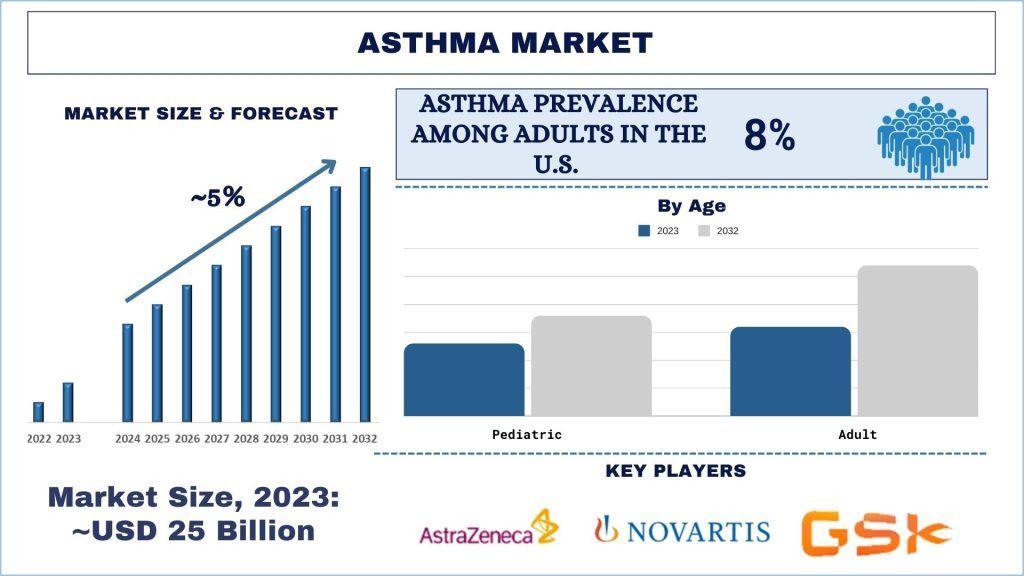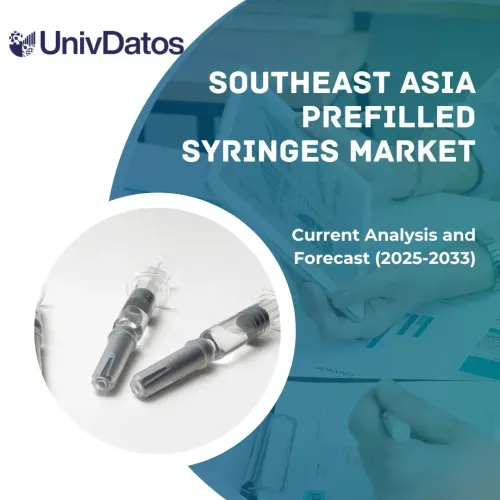- Home
- About Us
- Industry
- Services
- Reading
- Contact Us
Asthma Disease Market Insight, Epidemiology, & Forecast (2024-2032F)
Emphasis on Marketed Therapies [TEZSPIRE, TRELEGY ELLIPTA, ARNUITY ELLIPTA, CINQAIR (reslizumab), FASENRA, (benralizumab), DUPIXENT (dupilumab), NUCALA (mepolizumab), AIRSUPRA (albuterol and budesonide), and XOLAIR (omalizumab)]; Emerging Therapies [GSK3511294, Givinostat, Masitinib (AB07105), PT010, Dexpramipexole Dihydrochloride, PBF-680, ARS 1, MEDI3506 (tozorakimab), AZD1402 (PRS-060), and Atuliflapon (AZD5718)] and Country
Asthma Market Size & Forecast
The Asthma Market was valued at approximately USD 25 Billion in 2023 and is expected to grow at a strong CAGR of around ~5% during the forecast period (2024-2032) owing to the robust pipeline activity, advancements in genetic research, and patient-centered drug development.
Asthma Market Analysis
The Asthma Market is experiencing significant growth, driven by the rising prevalence of asthma globally and advancements in therapeutic options. This market encompasses a wide range of treatments, including bronchodilators, inhaled corticosteroids, combination inhalers, leukotriene modifiers, and biologics, addressing various needs from quick relief to long-term control. Increasing awareness about asthma management, improved diagnostic techniques, and the development of personalized medicine are contributing to market expansion. Additionally, supportive government policies and growing healthcare expenditure are enhancing access to advanced asthma treatments. Major pharmaceutical companies are heavily investing in research and development, further propelling market growth and innovation.
The global aging population is a significant driver of the Asthma Market. As people age, the risk of developing Asthma increases due to cumulative exposure to risk factors such as smoking and environmental pollutants. According to the World Health Organization (WHO), the number of people aged 60 years and older is expected to double by 2050, reaching about 2.1 billion, thereby expanding the potential patient pool for asthma.
Asthma: Disease Overview
Cause: Smoking is the primary risk factor for ASTHMA, and despite public health efforts to reduce smoking prevalence, it remains a widespread habit, particularly in developing countries. The WHO estimates that there are over 1.3 billion tobacco users worldwide, and this persistent smoking habit continues to drive ASTHMA incidence rates.
Environmental Factors: Increased exposure to air pollution, occupational dust, and chemicals is another significant driver of the Asthma Market. Urbanization and industrialization in emerging economies contribute to higher exposure levels, exacerbating the incidence of asthma.
In Asthma, adoption, and implementation efforts have led to significant disease management and patient care advancements. Regulatory approvals for innovative therapies, such as exon-skipping drugs and gene therapies, provided patients with access to treatments targeting the underlying genetic causes of the disease.
Asthma: Diagnosis
Asthma diagnosis involves a combination of medical history, physical examination, and diagnostic tests. Physicians begin by assessing symptoms such as wheezing, shortness of breath, chest tightness, and coughing, especially if these symptoms worsen at night or with exercise. A detailed medical history helps identify potential triggers and family history of asthma or allergies. Pulmonary function tests, like spirometry, measure lung function by evaluating airflow and volume, aiding in confirming the diagnosis. Additional tests, such as peak flow monitoring, methacholine challenge, and allergy testing, may be conducted to rule out other conditions and identify specific asthma triggers.
Asthma: Treatment
Asthma treatment encompasses a multifaceted approach designed to control symptoms, prevent exacerbations, and enhance patients’ quality of life. Central to Asthma management are bronchodilators, which include short-acting beta-agonists (e.g., albuterol) providing rapid relief by relaxing the muscles surrounding the airways during acute attacks. For long-term control, inhaled corticosteroids (e.g., fluticasone, budesonide) are pivotal, as they reduce chronic inflammation and airway hyperresponsiveness. Combination inhalers, which pair inhaled corticosteroids with long-acting beta-agonists (e.g., fluticasone/salmeterol), are often prescribed for moderate to severe Asthma to provide sustained symptom relief and improve lung function.
Leukotriene modifiers, such as montelukast, offer an additional layer of control by blocking leukotrienes, chemicals that contribute to inflammation and bronchoconstriction. These oral medications are particularly beneficial for patients with aspirin-sensitive Asthma or those who prefer an alternative to inhaled medications. For individuals with severe Asthma, biologics, such as omalizumab and mepolizumab, represent advanced therapeutic options. These monoclonal antibodies target specific pathways involved in the inflammatory process, providing relief for patients who do not respond adequately to conventional treatments.
Immunotherapy is another strategy, particularly effective for Asthma triggered by allergies. Through allergy shots or sublingual tablets, patients can achieve desensitization to specific allergens, thereby reducing Asthma symptoms. Additionally, lifestyle and environmental control measures play a crucial role in Asthma management. Identifying and avoiding triggers, such as allergens, smoke, and pollution, along with maintaining a healthy lifestyle through regular exercise and weight management, are essential components of treatment.
Education and self-management are equally vital. Patients must be equipped with knowledge about proper inhaler techniques, the importance of medication adherence, and how to recognize early signs of worsening Asthma. Regular monitoring and follow-up with healthcare providers ensure that the treatment plan is effective and adjustments are made as needed, providing a personalized and proactive approach to Asthma care.
Asthma: Therapeutic Strategies
Asthma management involves a range of therapeutic strategies aimed at controlling symptoms, preventing exacerbations, and improving overall quality of life. Key strategies include:
- Bronchodilators: Quick-relief medications such as short-acting beta-agonists (e.g., albuterol) are used to relax the muscles around the airways during an Asthma attack, providing immediate symptom relief.
- Inhaled Corticosteroids: These anti-inflammatory medications (e.g., fluticasone, budesonide) are the cornerstone of long-term Asthma control, reducing airway inflammation and preventing chronic symptoms.
- Combination Inhalers: Containing both inhaled corticosteroids and long-acting beta-agonists (e.g., fluticasone/salmeterol), these inhalers provide both immediate and long-term symptom control, making them suitable for moderate to severe Asthma.
- Leukotriene Modifiers: Oral medications like montelukast block leukotrienes, inflammatory chemicals the body releases during an Asthma attack, helping to prevent and control Asthma symptoms.
- Biologics: Targeted therapies such as monoclonal antibodies (e.g., omalizumab, mepolizumab) are used for severe Asthma, particularly in patients with specific phenotypes or those not responding to standard treatments.
- Immunotherapy: Allergy shots or sublingual tablets may be recommended for Asthma triggered by allergies, aiming to desensitize the immune system to specific allergens.
- Lifestyle and Environmental Control: Avoiding Asthma triggers, such as allergens, smoke, and pollution, along with regular exercise and maintaining a healthy weight, are crucial in managing Asthma.
Asthma: Epidemiology
The report on Asthma epidemiology includes both historical and forecasted data, segmented by various parameters. It covers:
- Total Prevalent Population of Asthma in the 7MM
- Severity-specific cases of Asthma
- Type-specific cases of Severe Asthma
- Age-specific Prevalent Population of Asthma in the 7MM
The analysis spans the 7MM market, including the United States, EU5 countries (Germany, France, Italy, Spain, and the United Kingdom), and Japan, from 2024 to 2032.
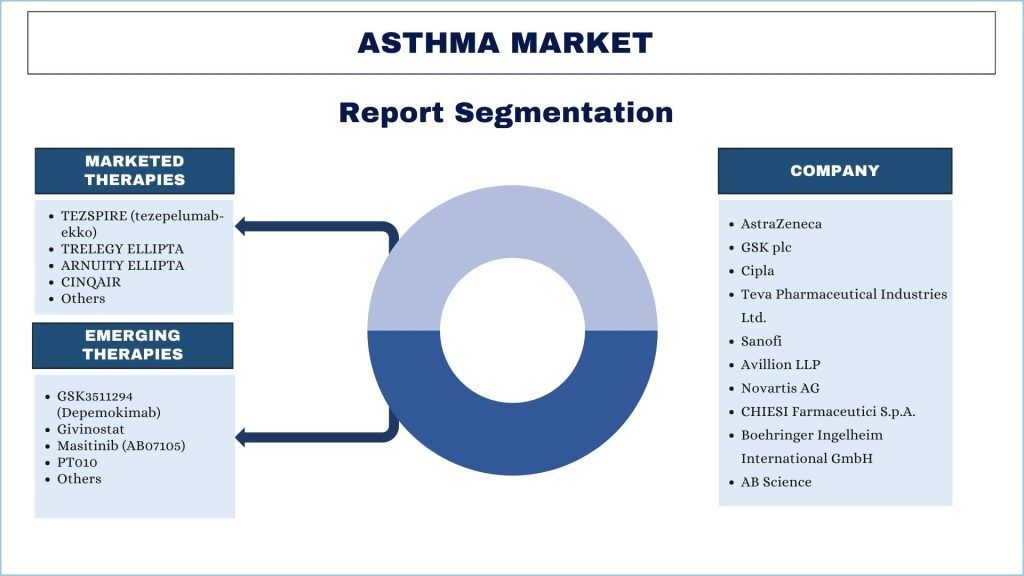
Major Insights:
This section provides an overview of the Asthma epidemiology across the 7MM regions.
- Individuals aged 60 and older had the highest Asthma prevalence in the U.S. at 34%.
- Smoking is the primary cause, with additional risks from occupational hazards and air pollution.
- Asthma places a considerable economic burden on healthcare systems due to high treatment costs, hospital admissions, and long-term management needs.
The United States holds the dominant share of the market in 2023.
In 2023, the United States holds a dominant share of the Asthma Market due to several key factors. The country’s advanced healthcare infrastructure and significant investment in medical research and development foster the continuous innovation of Asthma treatments. The high prevalence of Asthma among the population, coupled with widespread awareness and early diagnosis, drives substantial demand for both preventive and therapeutic medications. Additionally, strong governmental support and favorable reimbursement policies make advanced treatments more accessible to patients. The presence of leading pharmaceutical companies in the U.S. accelerates the introduction of cutting-edge therapies, ensuring the market’s growth. Moreover, extensive clinical trials and regulatory approvals in the U.S. set global standards, further cementing its leadership position in the Asthma Market.
Asthma: Drug Profile
Asthma medications are crucial for managing symptoms and preventing attacks. Bronchodilators, such as albuterol, provide quick relief by relaxing airway muscles. Inhaled corticosteroids, like fluticasone, reduce inflammation and prevent long-term symptoms. Combination inhalers, containing both corticosteroids and long-acting bronchodilators, offer comprehensive control for moderate to severe Asthma. Leukotriene modifiers, such as montelukast, block inflammatory chemicals and are often used for long-term management.
Asthma: Marketed Therapies
TEZSPIRE (tezepelumab-ekko):
Description
TEZSPIRE (tezepelumab-ekko) is a monoclonal antibody medication used to treat severe Asthma. It works by targeting and inhibiting thymic stromal lymphopoietin (TSLP), a key cytokine involved in the inflammatory response associated with Asthma. TEZSPIRE is designed for patients who do not achieve adequate control with standard therapies, reducing the frequency of Asthma exacerbations. Administered via subcutaneous injection, it offers a new treatment option for individuals with difficult-to-control Asthma. Approved by the FDA, TEZSPIRE represents a significant advancement in biologic therapies for respiratory conditions.
Detailed Product Information Included in the Report…
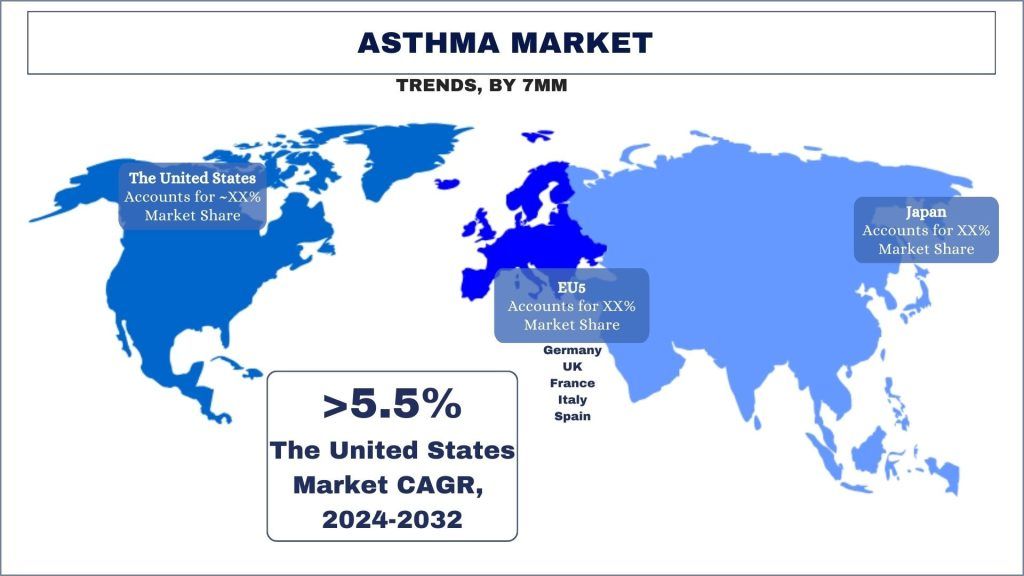
Asthma Industry Overview
The Asthma Market is competitive, with several 7MM and international market players. The key players are adopting different growth strategies to enhance their market presence, such as partnerships, agreements, collaborations, new product launches, geographical expansions, and mergers and acquisitions. Some of the major players operating in the market are AstraZeneca, GSK plc, Cipla, Teva Pharmaceutical Industries Ltd., Sanofi, Avillion LLP, Novartis AG, CHIESI Farmaceutici S.p.A., Boehringer Ingelheim International GmbH, and AB Science.
Asthma Market News
- February 2023, Pulmatrix initiated a Phase 2b trial, dosing the first patient with PUR1900 for Allergic Bronchopulmonary Aspergillosis (ABPA) and Asthma. The global study will assess safety, tolerability, and efficacy over 16 weeks, supporting Pulmatrix’s collaboration with Cipla to bring therapy to patients with Asthma, with proof-of-concept data expected by mid-2024.
Asthma Market Report Coverage
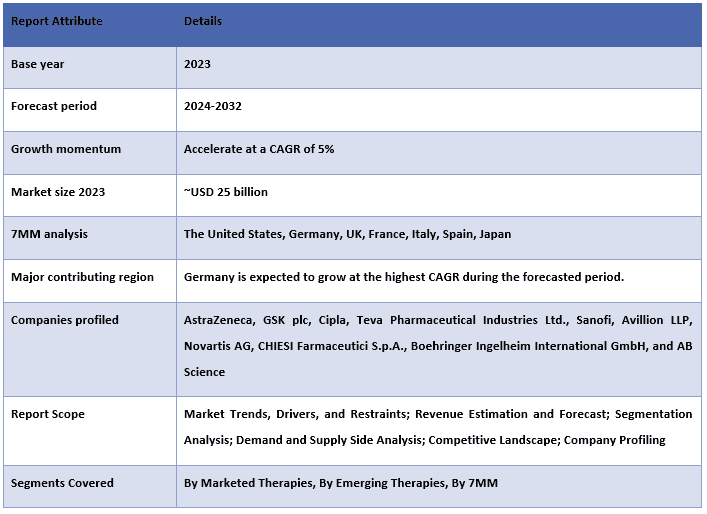
Reasons to buy this report:
- The study includes market sizing and forecasting analysis validated by authenticated key industry experts.
- The report presents a quick review of overall industry performance at one glance.
- The report covers an in-depth analysis of prominent industry peers with a primary focus on key business financials, product portfolios, expansion strategies, and recent developments.
- Detailed examination of drivers, restraints, key trends, and opportunities prevailing in the industry.
- The study comprehensively covers the market across different segments.
- Deep dive regional level analysis of the industry.
Customization Options:
The Global Asthma Market can further be customized as per the requirement or any other market segment. Besides this, UMI understands that you may have your own business needs, hence feel free to connect with us to get a report that completely suits your requirements.
Table of Content
Research Methodology for the Asthma Market – Epidemiology & Market Forecast (2024-32F)
Analyzing the historical market, estimating the current market, and forecasting the future market of the Asthma Market were the three major steps undertaken to create and analyze the total prevalent population of Asthma and adoption of Asthma therapeutics in 7 Major Markets. Exhaustive secondary research was conducted to collect the historical market numbers and prevalence of diseases and estimate the current market size. Secondly, to validate these insights, numerous findings and assumptions were taken into consideration. Moreover, exhaustive primary interviews were also conducted with industry experts across the value chain of the global Asthma market. For the assumption and validation of market numbers through primary interviews, we employed a top-down/bottom-up approach to forecasting the patient population and complete market size. Thereafter, market breakdown and data triangulation methods were adopted to estimate and analyze the market size of segments and sub-segments of the industry. Detailed methodology is explained below:
Analysis of Historical Market Size
Step 1: In-Depth Study of Secondary Sources:
An extensive secondary study was conducted to gather data on prevalence/incidence rates, diagnostic rates, treatment rates, historical market sizes, etc., for the Asthma Market. This involved utilizing internal sources such as annual reports & financial statements, performance presentations, press releases, etc., and external sources including journals, news & articles, government publications, competitor publications, sector reports, third-party databases, and other credible publications. This step ensured a robust understanding of the market’s epidemiology and historical context.
Step 2: Exhaustive Epidemiological Investigation
To enhance the accuracy of epidemiological data, we employed a multi-step approach:
Literature Review: An exhaustive review of peer-reviewed journals, clinical trial data, and epidemiological studies to establish baseline prevalence and incidence rates.
Database Analysis: Utilization of specialized databases such as WHO, CDC, and national health registries to corroborate findings and refine prevalence and incidence estimates.
Cross-Validation: Cross-referencing data from multiple sources to ensure consistency and reliability of epidemiological estimates.
Step 3: Market Segmentation:
After obtaining the historical market size of the Asthma Market, we conducted a detailed secondary analysis to gather historical market insights and share for different segments, sub-segments, and products for major regions. The report includes major segments such as marketed therapies, emerging therapies, and regions. Further country-level analyses were conducted to evaluate the overall adoption of testing models in that region.
Step 4: Factor Analysis:
After acquiring the historical data of different segments and sub-segments, we conducted a detailed factor analysis to estimate the current scenario of the Asthma market. Further, we conducted factor analysis using dependent and independent variables such as Marketed Therapies, Emerging Therapies, and the country (7MM) of the Asthma market. A thorough analysis was conducted for demand and supply-side scenarios considering top partnerships, mergers and acquisitions, business expansion, and product launches in the Asthma market sector.
Current Market Size Estimate & Forecast
Current Market Sizing: Based on actionable insights from the above 3 steps, we arrived at the current market size, key players in the Asthma Market, and market shares of the segments. All the required percentage shares split, and market breakdowns were determined using the above-mentioned secondary approach and were verified through primary interviews.
Estimation & Forecasting: For market estimation and forecast, weights were assigned to different factors including drivers & trends, restraints, and opportunities available for the stakeholders. After analyzing these factors, relevant forecasting techniques i.e., the top-down/bottom-up approach were applied to arrive at the market forecast for 2032 for different segments and sub-segments across the 7 major markets. The research methodology adopted to estimate the market size encompasses:
The industry’s market size, in terms of revenue (USD) the prevalent population and available treatments for Asthma, and the adoption rate of the Asthma market across the 7 major markets domestically
All percentage shares, splits, and breakdowns of market segments and sub-segments
Key players in the global Asthma market in terms of products offered. Also, the growth strategies adopted by these players to compete in the fast-growing market.
Market Size and Share Validation
Primary Research: In-depth interviews were conducted with the Key Opinion Leaders (KOLs) including Top Level Executives (CXO/VPs, Sales Head, Marketing Head, Operational Head, Regional Head, Country Head, etc.) across major regions. In Addition to this, interviews with healthcare professionals including physicians, surgeons, and specialist doctors were also conducted to get epidemiology-specific insights. Primary research findings were then summarized, and statistical analysis was performed to prove the stated hypothesis. Inputs from primary research were consolidated with secondary findings, hence turning information into actionable insights.
Split of Primary Participants in Different Regions
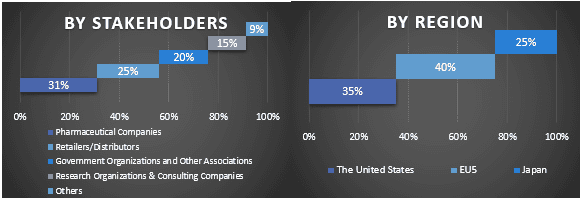
Market Engineering
The data triangulation technique was employed to complete the overall market estimation and arrive at precise statistical numbers for each segment and sub-segment of the Global Asthma Market. After studying various parameters and trends in the marketed therapies, emerging therapies, and regions of the Global Asthma Market, data was split into several segments and sub-segments.
The main objective of the Global Asthma Market Study
The current & future market trends of the Global Asthma Market were pinpointed in the study. Investors can gain strategic insights to base their discretion for investments on the qualitative and quantitative analysis performed in the study. Current and future market trends determined the overall attractiveness of the market at a regional level, providing a platform for the industrial participant to exploit the untapped market to benefit from a first-mover advantage. Other quantitative goals of the studies include:
- Analyze the current and forecast market size of the Asthma market in terms of value (USD). Also, analyze the current and forecast market size of different segments and sub-segments.
- Accurately estimate the prevalence and incidence rates of Asthma and understand the diagnostic and treatment rates, aiding in the identification of unmet medical needs and potential market opportunities.
- Segments in the study include areas of the marketed therapies, emerging therapies, and regions.
- Define and analyze the regulatory framework for the Asthma
- Analyze the current and forecast market size of the Asthma market for the 7 major Markets.
- Major countries of regions studied in the report include the United States, Germany, the UK, France, Italy, Spain, and Japan.
- Company profiles of the Asthma market and the growth strategies adopted by the market players to sustain in the fast-growing market.
- To conduct country-level analyses to evaluate the adoption of testing models and therapies in specific regions.
Frequently Asked Questions FAQs
Q1: What is Asthma?
Q2: What is the Asthma market's current market size and growth potential?
Q3: What are the driving factors for the growth of the Asthma market?
Q4: What is the overall Asthma epidemiology scenario in 7MM?
Q5: Which country will dominate the Asthma market?
Related Reports
Customers who bought this item also bought

